We're 100% independent
Find the top Canadian online casinos
Get the biggest welcome bonuses

We're 100% independent
Find the top Canadian online casinos
Get the biggest welcome bonuses

Gambling is heavily regulated in most states, but some people believe it's prevalent among video games. Loot boxes, or in-game microtransactions, date back to collectible cards hidden in cigarette packs. However, bright lights, microfeedback, and attention-grabbing sounds aren't the only things that blur the line between video games and slot machines – video game loot boxes allow players to wager money on the off chance of opening something of virtual value, causing many to perceive loot boxes and gambling as one and the same.
Despite video game companies rejecting that notion, government officials from all over the world are investigating loot boxes and drafting legislation to block microtransactions in games played by children under the age of 18. But how does the public feel about them? Do players take the side of video game developers, or do they feel the addictive effects themselves? We surveyed 1,000 gamers to learn about their experiences with loot boxes and how microtransactions are viewed from the other side of the controller. Keep reading to see what they had to say.
Gamers spending real money on virtual loot boxes have created an almost $30 billion industry, and while the cost of microtransactions is dependent on the game, 70.5% of surveyed gamers had purchased a loot box. Men and gamers who preferred multiplayer online battle arena (MOBA) games were the most likely to do so, with 74% of male gamers and 81% of those favoring the MOBA genre having made a purchase. And it doesn't stop at console video games – 1 in 3 gamers had purchased a loot box in a mobile game.
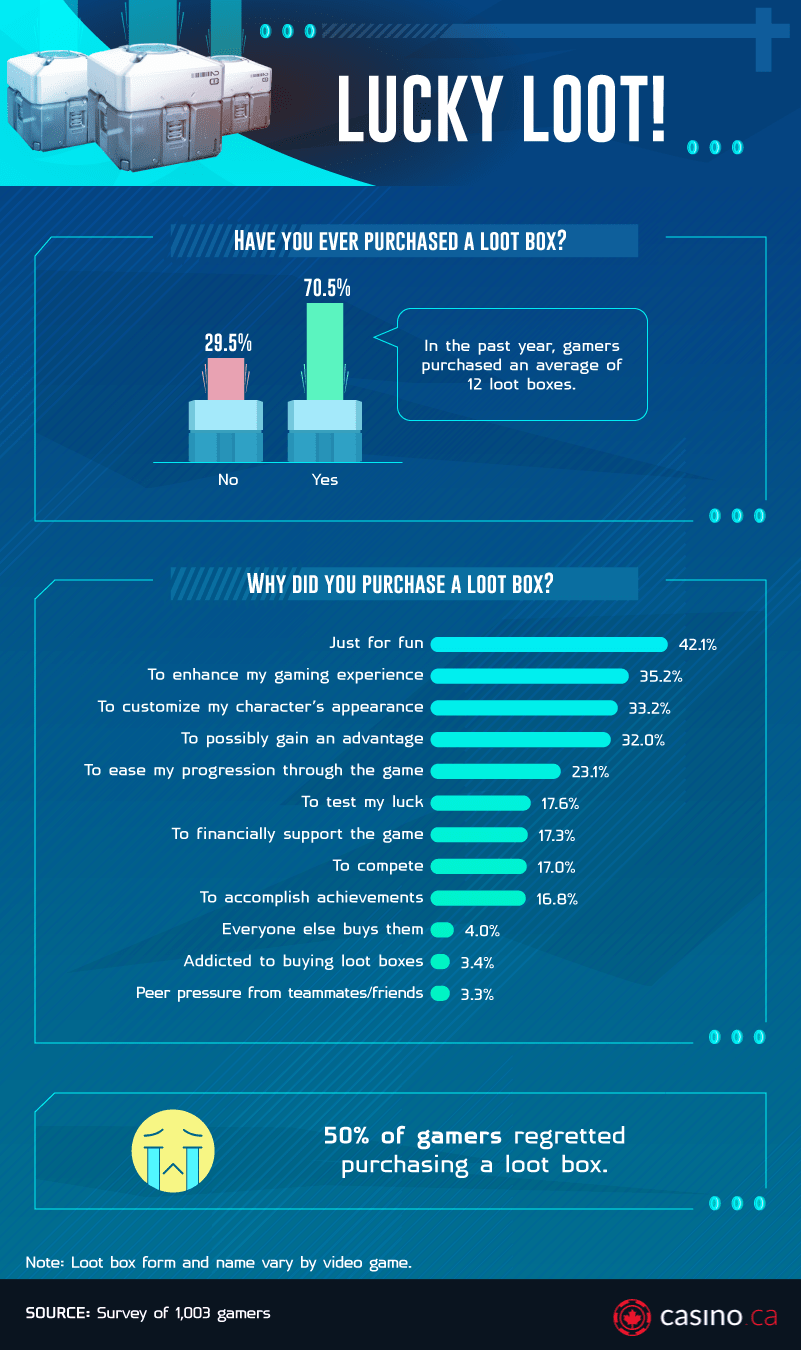
The goal of purchasing loot boxes isn't always to win additional weapons, character attire, or enhanced abilities – 42% of players said they'd bought a box just for fun. Aside from the dopamine rush brought on by opening a box with unknown contents, 35.2% of gamers purchased a loot box to enhance their gaming experience, while 33.2% and 32% did so to customize their character's appearance and take a chance on gaining an advantage, respectively.
With no clear odds or any regulations, the outcomes of loot boxes are often disappointing. So much so that half of gamers who spent their hard-earned money on virtual risk-taking regretted doing so. Poor outcomes seem to be enough to turn players against loot boxes, but some claim that increased regulation like clear odds, no duplicates, and security steps to protect children would be better than an overall ban.

From character attire and skins to weapon colors and dance moves, opening a loot box typically results in simple cosmetic changes. While every game has different odds and optional items to earn, the most common loot box gains were gear, weapons, and in-game currency. While 40.6% of gamers said they had received gear in a loot box, 38.3% and 36.5% said they received a weapon and in-game currency, respectively.
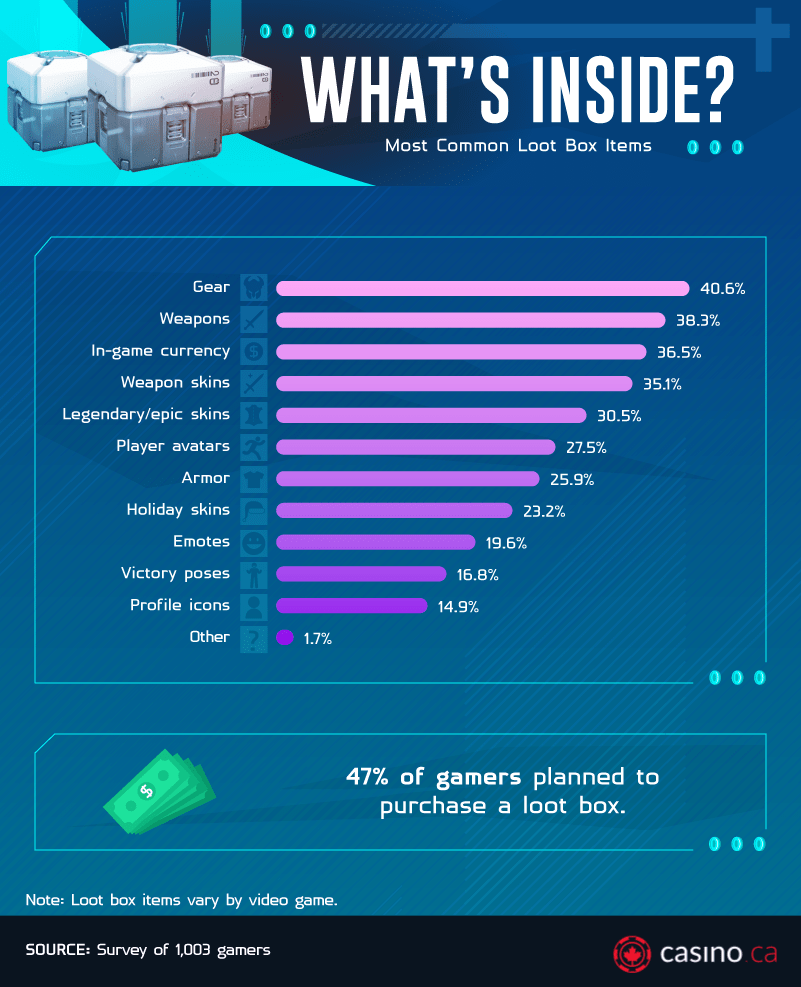
Emotes, victory poses, and profile icons were significantly more rare: Less than 20% of gamers received these items through a loot box purchase. Nevertheless, the unpredictable odds and increased chances of disappointment didn't seem to slow down people's purchases – 47% of gamers still planned on purchasing loot boxes in the future.

While the loot box industry is already approaching the $30 billion mark, research shows gamers will spend nearly $50 billion by 2022. Of course, if the proposed legislation is passed, loot box purchases may slow down, but some gamers have already admitted to spending nearly $800 on loot boxes in one month alone. According to our data, the amount that gamers spent in the past year ranged from a low of just $5 to a high of $500. Of all in-game purchases, players spent the most on loot boxes – an average of $217 – but also dabbled in downloadable content (DLC) and season passes.
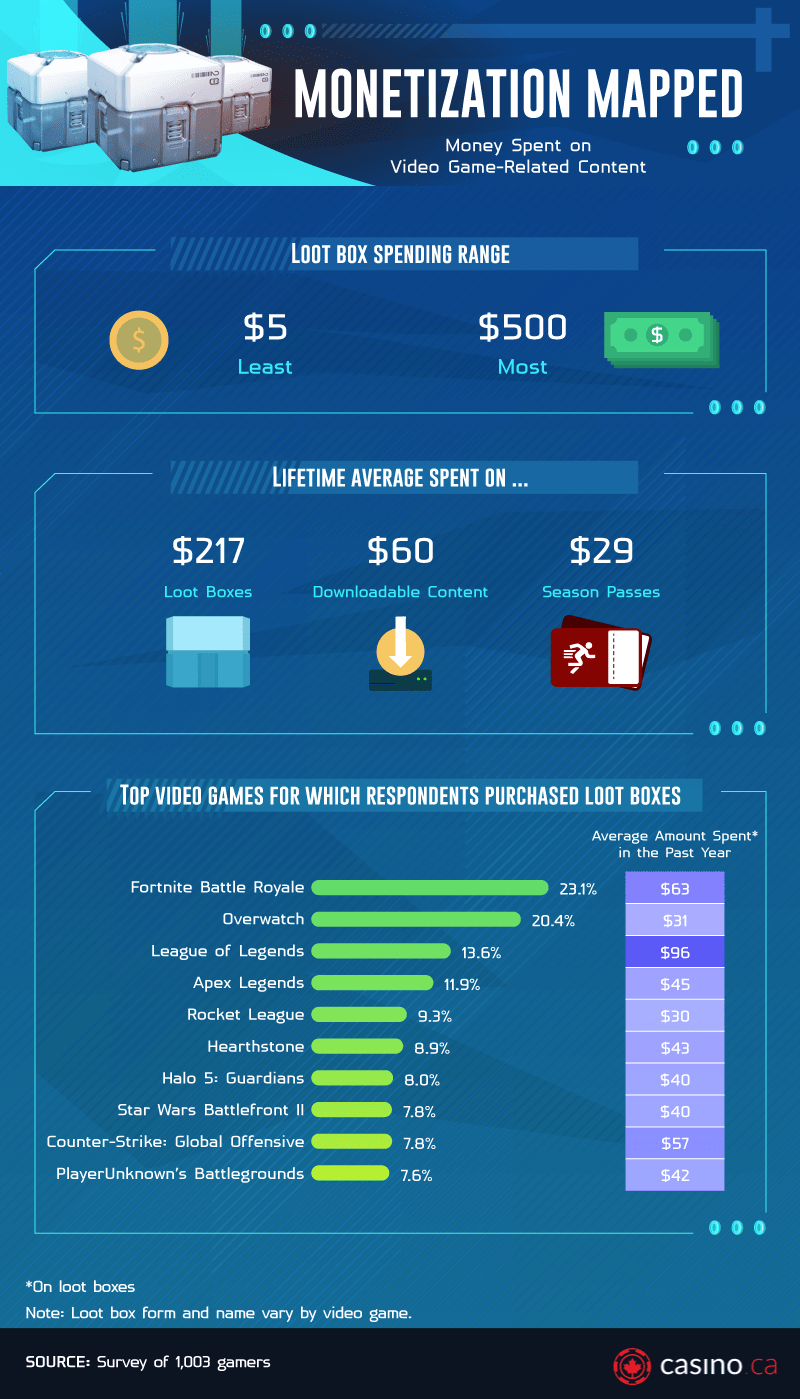
It's hard to find a video game nowadays that doesn't at least offer purchasable content. But spending money on in-game items after already having bought a game seems redundant. That may be why Fortnite Battle Royale is where gamers bought the most loot boxes. The biggest game in the world also happens to be free, and while plenty of players enjoy it without spending a cent, 23.1% of surveyed gamers had purchased Fortnite loot boxes, spending an average of $63 in the past year.
However, 20.4% of gamers bought loot boxes for pay-to-play Overwatch, while 13.6% did so in League of Legends. Despite accounting for fewer purchases, the latter cost players more money: Those who bought loot boxes in Overwatch spent an average of $31 in the past year, while those who made in-game purchases in League of Legends spent an average of $96. League of Legends wasn't the only game in which players splurged on, though. While only 7.8% of respondents said they had purchased loot boxes in Counter-Strike: Global Offensive, they spent $57 in the past year, on average.
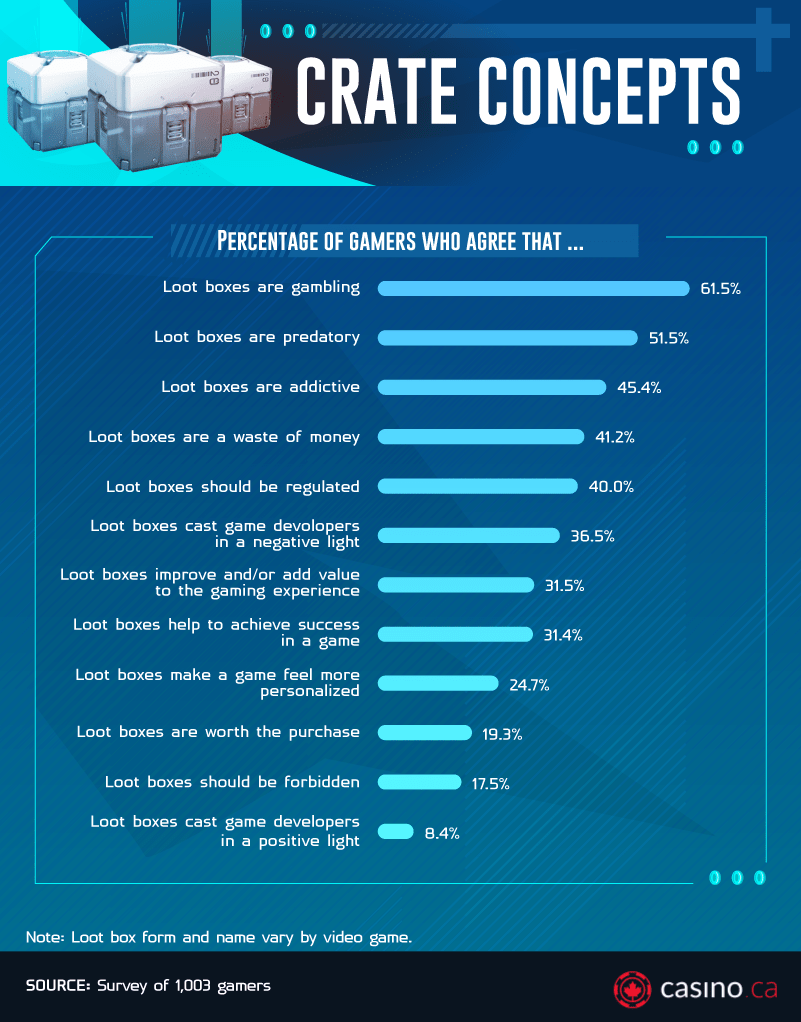
Video game developers didn't create loot boxes to trap gamers into gambling or addiction – developers claim they help pay off development costs and even allow games to be offered for free – but on the other side of the console, the majority of gamers believed loot boxes were like gambling and were predatory. Over 40% of players also believed loot boxes to be addictive and a waste of money. In fact, the overarching perception of loot boxes was negative – only 19.3% of gamers said they were worth the price, while 8.4% said they cast a positive light on game developers.
The proposed legislation to ban loot boxes and play-to-win features is primarily directed toward games designed for children. Given an increase in young gamblers, fingers have been pointed at the United States and video game loot boxes – but are parents on board with the ban? While 63.3% of parents said they've never purchased a loot box for their children, 36.7% had, spending an average of $41.
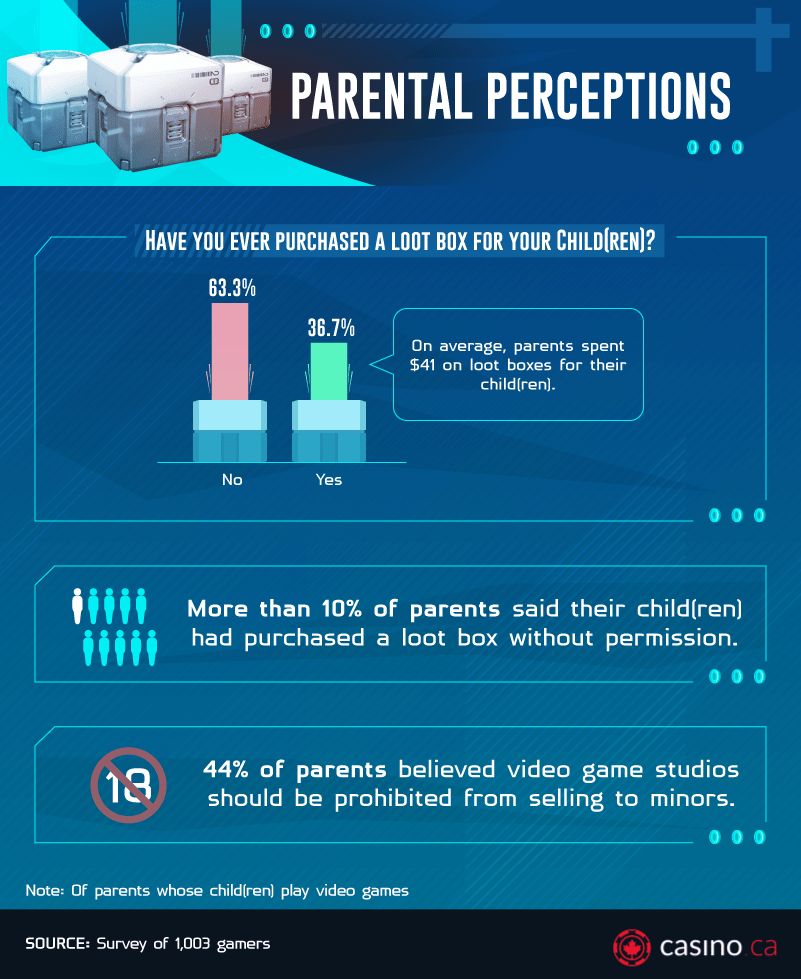
But without any current regulation for in-game purchases, gamers under the age of 18 don't need parental permission to buy a loot box. Luckily, 76.3% of parents said their child had never made a purchase without their consent, but 14.1% said they had, and 9.5% weren't even sure. The risk, uncertainty, and potential consequences of children purchasing loot boxes led 44% of parents to believe that video games studios should be prohibited from selling to minors.
Loot boxes have essentially been around for over a century. But what started as card collecting has turned into video game risk-taking, catching the attention of researchers, psychologists, and government officials. The current wagering that is necessary to get the best gameplay out of numerous games has become much more than an attempt to increase profit margins – it's now seen as gambling, predatory, and addictive. Gamers are dishing out hundreds to thousands of dollars in the hopes of attaining items with temporary virtual value, but whether they support the proposed legislation, the world of gaming may be forever changed.
For this analysis, we administered 1,003 online surveys to gamers in the United States. To qualify for this survey, respondents were required to pass a series of questions that ultimately determined gamer status. In this study, participants were considered gamers if they met the following criteria:
Respondents who failed to meet these requirements were ejected from the survey. Additionally, an attention-check question was used to identify and disqualify respondents who didn't read questions in their entirety. Of the 1,003 gamers surveyed, 389 were female, 608 were male, and six identified as neither male nor female. The average age of respondents was 31 with a standard deviation of 8. This survey had a margin of error of plus or minus 3%.
A limitation of this study is that loot boxes may vary in form (card packs in Hearthstone, for example) and price by video game title. Moreover, due to the threat of federal regulations and new laws passing around the world, video game developers may have changed the mechanisms of loot boxes in their games ("see-through" loot box llamas in Fortnite, for example) to avoid potential penalization. Gamers were asked about both their all-time purchases of loot boxes as well as purchases in the past year.
These data were compiled via a self-reported survey on SurveyMonkey and hosted on Amazon's Mechanical Turk. Self-reported data are often limited in their accuracy due to a wide variety of issues, which may include but aren't limited to the following: attribution, exaggeration, telescoping, and recency bias. An attempt was made to reduce bias throughout the questionnaire.
Discussions about loot boxes typically share the opinions of experts and government officials, but gamers' voices deserve to be heard too. If you'd like to add our findings to the ongoing conversation, feel free to share this project. The graphics and content found here are available for noncommercial reuse. We just ask that you link back to this page to give the authors proper credit.